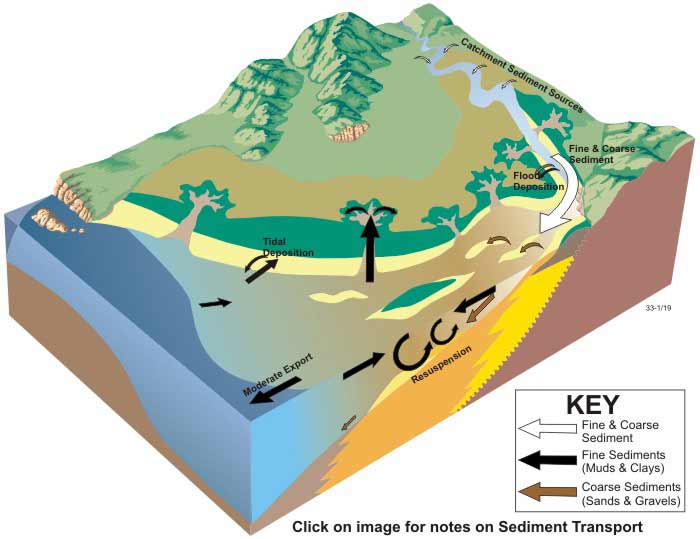
Sediment transport processes in tide-dominated estuaries
1. Catchment freshwater input
Fine and coarse sediment enters the estuary from the catchment. The amount of sediment input varies regionally, depending on catchment and climatic conditions, and the volume of freshwater input. However, the amount of terrigenous sediment delivered to tide-dominated estuaries is usually relatively large.
2. Deposited sediment
Sediment is deposited at the point where the river flow and tidal currents meet and cancel each other out. As a result of this rapid decrease in the capacity of the river to transport sediment, most of the coarse material (such as gravels and sands) is deposited. Reworking and redeposition of material by tidal currents occurs, typically preventing the development of a distinct fluvial delta in tide-dominated estuaries.
3. Suspended sediment
Large quantities of suspended sediment are characteristic of tide-dominated estuaries; strong tidal currents continually resuspended and rework fine sediment in the channels, so that the water column is naturally highly turbid (Turner et al., 1994, Wells, 1995). Quantities of fine and coarse sediment can pool temporarily within the channel, forming tidal sand banks. A zone of abnormally high suspended sediment can occur in many tide-dominated estuaries, known as the ‘turbidity maximum’ (Wells, 1995). This typically transient feature develops as a result of trapping and resuspension of particles, and contributes to the deposition of material in the tidal sand banks. High suspended sediment loads can also lead to a phenomenon known as ‘fluid muds’, a gel-like accumulation of low density muddy sediment which may be stationary, or mobilised by tidal currents (Wells, 1995). Turbidity is especially marked during spring tides, and the location of the turbidity maximum is variable within estuaries, depending on the tidal cycle (spring to neap) and river flow velocity (Semeniuk, 1982). Ebb and flood tides can follow mutually-evasive channels (which periodically migrate), and currents may be powerful enough to cause scouring at the channel base, leaving gravel and bioclastic debris at the base (Green et al., 2000, Harris, 1988).
4. Deposition and erosion of fine sediment
Fine sediment undergoes both deposition and erosion on the extensive intertidal flats (Dyer, 1998, Woodroffe et al., 1999, Masselink et al., 2000). Deposition is aided by biological activity such as burrowing and improved cohesiveness (Ruddy et al., 1998, Murray et al., 2002), whereas erosion is typically related to storms and tides (Dyer, 1998). Coarser material is also deposited on flanking environments by tidal currents and flood events. Over time, intertidal flats tend to expand seawards (Nichols 1999, Green et al., 2001).
5. Mangrove environments
Mangrove environments, with interspersed tidal drainage channels, commonly flank tide-dominated estuaries, and serve as a depocentre for fine sediment. Tidal asymmetry (higher energy short duration flood tides, and lower energy long duration ebb tides), baffling by mangrove vegetation, and percolation of tidal water through animal burrows results in the trapping and rapid deposition of fine sediment and organic material (Bowers et al., 1997, Alongi et al., 2001). Over time, mangrove environments tend to expand onto, and replace intertidal flats (Woodroffe et al., 1999).
6. Saltflat environments
Saltflat environments experience inundation only during king tides, during which some deposition of fine sediment occurs (Flood et al., 1986). Sediment in supra-tidal regions (including the floodplain) is mostly mud, which is deposited during high tides or river floods (Roy et al., 1981). Ebb tide waters often flow back to the main estuarine channel through tidal drainage channels.
7. Exchange of marine water
The sediment trapping efficiency of tide-dominated estuaries is moderate because they are generally highly energetic and turbid systems, and mixing of seawater and freshwater results in the loss of suspended sediment to the open ocean (Harris et al., 2003). Coarse sediment tends to be redistributed by tides, and result in the seaward expansion of intertidal habitats and infilling of the main channels with tidal sand banks. Net sediment export is more significant during extreme flood events, when large quantities of fine and coarse sediment are moved offshore.


